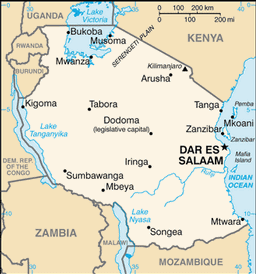Geography of Tanzania
Overview of the geography of Tanzania
Template:Geography of Tanzania
The Geography of Tanzania is diverse, encompassing a wide range of natural features and climatic zones. Tanzania is located in East Africa and is bordered by Kenya and Uganda to the north, Rwanda, Burundi, and the Democratic Republic of the Congo to the west, Zambia, Malawi, and Mozambique to the south, and the Indian Ocean to the east.
Topography[edit | edit source]
Tanzania's topography includes coastal plains, a central plateau, and highlands in the north and south. The country is home to Mount Kilimanjaro, the highest peak in Africa, which stands at 5,895 meters (19,341 feet). The Great Rift Valley runs through the country, creating a series of lakes and volcanic mountains.
Mountains[edit | edit source]
Lakes[edit | edit source]
Tanzania has several large lakes, including:
- Lake Victoria, the largest lake in Africa and the second-largest freshwater lake in the world by surface area.
- Lake Tanganyika, the second deepest and second largest by volume freshwater lake in the world.
- Lake Malawi, known locally as Lake Nyasa.
Rivers[edit | edit source]
The major rivers in Tanzania include:
Climate[edit | edit source]
Tanzania's climate varies from tropical along the coast to temperate in the highlands. The coastal areas experience a hot and humid climate, while the central plateau is dry and arid. The highlands have a more temperate climate with two rainy seasons: the long rains from March to May and the short rains from October to December.
Natural Resources[edit | edit source]
Tanzania is rich in natural resources, including minerals such as gold, diamonds, and tanzanite. The country also has significant deposits of natural gas and coal.
Flora and Fauna[edit | edit source]
Tanzania is renowned for its biodiversity and is home to numerous national parks and game reserves. The Serengeti National Park and the Ngorongoro Conservation Area are famous for their wildlife, including the annual Great Migration of wildebeest and zebras.
Environmental Issues[edit | edit source]
Tanzania faces several environmental challenges, including deforestation, soil erosion, and the impacts of climate change. Efforts are being made to address these issues through conservation programs and sustainable development initiatives.
Related Pages[edit | edit source]
- Mount Kilimanjaro
- Serengeti National Park
- Ngorongoro Conservation Area
- Lake Victoria
- Great Rift Valley
- Climate of Tanzania
- Wildlife of Tanzania
| Geography of Africa | ||||||
|---|---|---|---|---|---|---|
|
Search WikiMD
Ad.Tired of being Overweight? Try W8MD's NYC physician weight loss.
Semaglutide (Ozempic / Wegovy and Tirzepatide (Mounjaro / Zepbound) available. Call 718 946 5500.
Advertise on WikiMD
|
WikiMD's Wellness Encyclopedia |
| Let Food Be Thy Medicine Medicine Thy Food - Hippocrates |
Translate this page: - East Asian
中文,
日本,
한국어,
South Asian
हिन्दी,
தமிழ்,
తెలుగు,
Urdu,
ಕನ್ನಡ,
Southeast Asian
Indonesian,
Vietnamese,
Thai,
မြန်မာဘာသာ,
বাংলা
European
español,
Deutsch,
français,
Greek,
português do Brasil,
polski,
română,
русский,
Nederlands,
norsk,
svenska,
suomi,
Italian
Middle Eastern & African
عربى,
Turkish,
Persian,
Hebrew,
Afrikaans,
isiZulu,
Kiswahili,
Other
Bulgarian,
Hungarian,
Czech,
Swedish,
മലയാളം,
मराठी,
ਪੰਜਾਬੀ,
ગુજરાતી,
Portuguese,
Ukrainian
Medical Disclaimer: WikiMD is not a substitute for professional medical advice. The information on WikiMD is provided as an information resource only, may be incorrect, outdated or misleading, and is not to be used or relied on for any diagnostic or treatment purposes. Please consult your health care provider before making any healthcare decisions or for guidance about a specific medical condition. WikiMD expressly disclaims responsibility, and shall have no liability, for any damages, loss, injury, or liability whatsoever suffered as a result of your reliance on the information contained in this site. By visiting this site you agree to the foregoing terms and conditions, which may from time to time be changed or supplemented by WikiMD. If you do not agree to the foregoing terms and conditions, you should not enter or use this site. See full disclaimer.
Credits:Most images are courtesy of Wikimedia commons, and templates, categories Wikipedia, licensed under CC BY SA or similar.
Contributors: Prab R. Tumpati, MD





